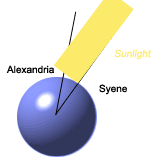Eratosthenes Measured Earth’s Circumference—Centuries Before Columbus Sailed
 Eratosthenes (c. 276 – 194 BC) was born more than 2200 years ago in the Greek city of Cyrene, now a city in the North African country of Libya. (The Greek Empire surrounded much of the Mediterranean Sea and included present day Greece, Turkey, the Middle East, and regions of northern Africa.) As a teen, Eratosthenes (air-uh-TOS-thuh-neez) was sent to Athens where he received the equivalent of a university education. Eventually, he solved problems and published works on geography, math and geometry, philosophy, and literature. At the age of 30, Eratosthenes was summoned to Alexandria by King Ptolemy III to tutor his son and to begin work at the great library at the Greek museum. Alexandria, now in Egypt, was the important city at the mouth of the Nile River. The museum was a center of learning, somewhat similar to today’s university research centers. Eratosthenes eventually became chief librarian.
Eratosthenes (c. 276 – 194 BC) was born more than 2200 years ago in the Greek city of Cyrene, now a city in the North African country of Libya. (The Greek Empire surrounded much of the Mediterranean Sea and included present day Greece, Turkey, the Middle East, and regions of northern Africa.) As a teen, Eratosthenes (air-uh-TOS-thuh-neez) was sent to Athens where he received the equivalent of a university education. Eventually, he solved problems and published works on geography, math and geometry, philosophy, and literature. At the age of 30, Eratosthenes was summoned to Alexandria by King Ptolemy III to tutor his son and to begin work at the great library at the Greek museum. Alexandria, now in Egypt, was the important city at the mouth of the Nile River. The museum was a center of learning, somewhat similar to today’s university research centers. Eratosthenes eventually became chief librarian.
At least 100 years before Eratosthenes was born, it was known that the earth was round. Observations supporting a spherical earth were recorded by Aristotle (384– 322 BC) in the fourth century BC. Eratosthenes knew this and wanted to measure earth’s circumference. Since no one could walk or sail around the earth, Eratosthenes realized he would have to somehow deduce earth’s circumference from observations he could make. He had learned, perhaps from travelers, that due south of Alexandria in the city of Syene (SI-ee-nee), now Aswan, Egypt, that at noon on the summer solstice, no shadows were cast. One could look down a well in the city and see the sunlight reflected straight back. No shadows formed on the walls of the well. But due north in Alexandria, shadows were always cast. Eratosthenes realized he could measure the angle of a shadow cast in Alexandria at the summer solstice then use geometry concepts of parallel lines and congruent angles to calculate earth’s circumference.
The angle of the shadow cast in Alexandria would be congruent to the angle at earth’s center between Syene and Alexandria. This angle was measured to be about 1/50 of a complete circle. Now Eratosthenes just needed to know the distance between Syene and Alexandria to set up a mathematical ratio to compute earth’s circumference. This is where the greatest error was introduced since the ancient Greeks had no accurate way to measure distances. Nevertheless, Eratosthenes was able to closely estimate earth’s circumference. Depending on the conversion factors used, Eratosthenes measured earth to be from 25,000 to 28,900 miles around. Today the accepted circumference of earth is 24,903 miles/40,075 km. Columbus used maps drawn by later Greeks which showed the earth to be much smaller. If he had used Eratosthenes’ measurements, he would have expected his travels to the West Indies to have been much further and perhaps would never have undertaken such a long journey!
About the Author
Claire-Jean Korzenewski, BS
 Claire-Jean Korzenewski has a B.S. in geology and experience in petroleum exploration. She is an educator with public school teaching experience in junior high and high school sciences. Claire-Jean is now a freelance writer who makes communications more effective - to inform, to educate, and to enhance profits for businesses and individuals.
Claire-Jean Korzenewski has a B.S. in geology and experience in petroleum exploration. She is an educator with public school teaching experience in junior high and high school sciences. Claire-Jean is now a freelance writer who makes communications more effective - to inform, to educate, and to enhance profits for businesses and individuals.


